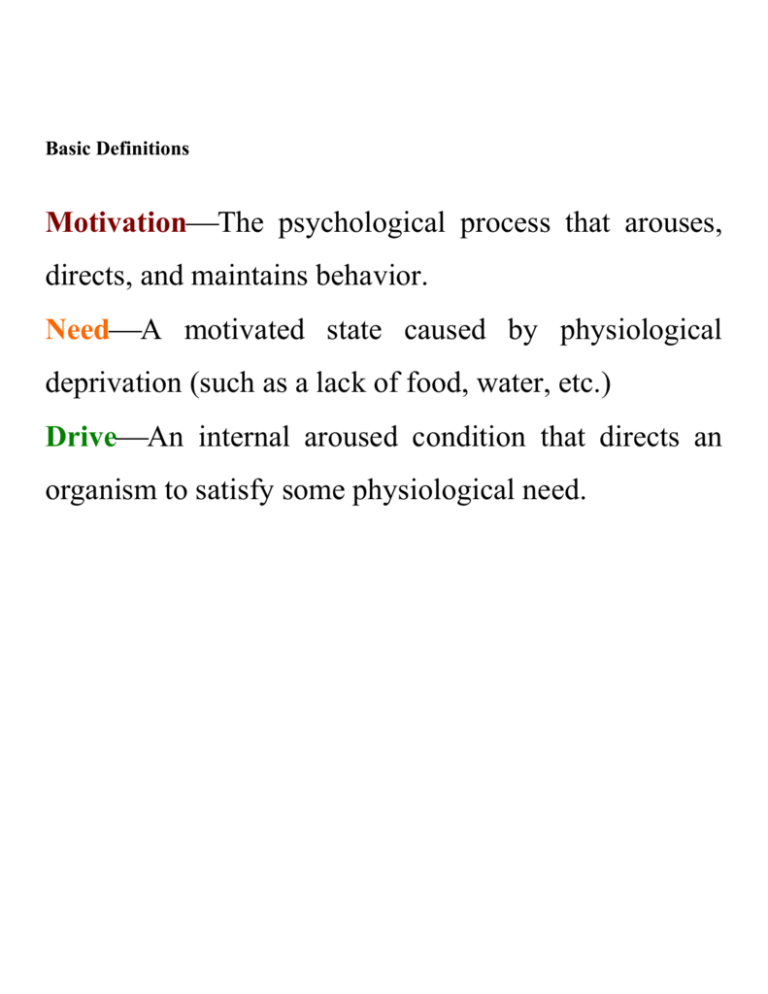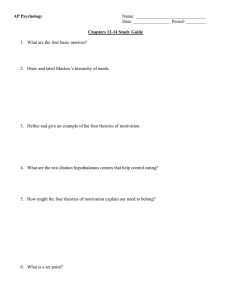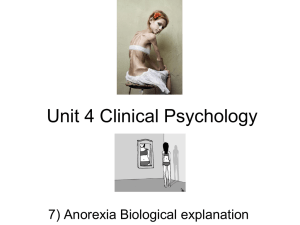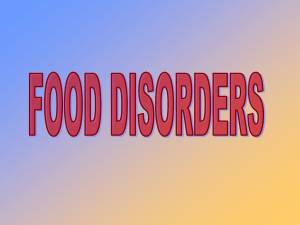Drive theories
advertisement

Basic Definitions MotivationThe psychological process that arouses, directs, and maintains behavior. NeedA motivated state caused by physiological deprivation (such as a lack of food, water, etc.) DriveAn internal aroused condition that directs an organism to satisfy some physiological need. Types of motivation Extrinsic motivationA type of motivation that engages people in various activities for a particular reward. Intrinsic motivationA type of motivation that engages people in various activities for no apparent reward except the pleasure and satisfaction of the activity itself. Individualist-success motivationA type of achievement motivation that affects one's attitudes and actions directed towards the attainment of personal goals. Collectivist-success motivationA type of achievement motivation that directs a person to connect with others; the individual’s contribution is seen as beneficial to the members of a particular group or society in general. Source: Shiraev E. and Levy, D. Cross-Cultural Psychology. (2007). Boston: Allyn and Bacon Theories of Motivation. Psychological Main focus of the theories approach Drive theories Pay attention to human needsmotivated states caused by physiological or psychological deprivation Arousal theories Suggest that people seek to maintain optimal levels of arousal by actively changing their exposure to arousing stimuli Emphasize the importance of unconscious Psychoanalytic processes in the individual’s thoughts and theories actions Focus on human happiness, dignity, Humanistic individual choice, self-improvement, and theories the individual’s self-worth Maintain that we are aware of our thought Cognitive patterns and therefore can control our theories motivation and overt behavior Source: Shiraev E. and Levy, D. Cross-Cultural Psychology. (2007). Boston: Allyn and Bacon Abraham Maslow's Hierarchy of Needs Level 5: Self-Actualization Level 4: Esteem Needs Level 3: Belonging and Love Needs Level 2: Safety Needs Level 1: Physiological Needs (Based on A. Maslow, Motivation and Personality, 1970.) Type of sex culture and general attitudes toward sex. Sex culture is a set of requirement, beliefs, symbols, and norms regarding sexuality and its expression. Features Traditional Sex Culture Expression of sexuality Premarital sex Extramarital sex Homosexuality Chastity Sex during late adulthood Non-Traditional Sex Culture Heavily regulated Prohibited and rejected Prohibited and rejected Prohibited and rejected High value ? Source: Shiraev E. and Levy, D. Cross-Cultural Psychology. (2007) Boston: Allyn and Bacon Somewhat regulated Somewhat tolerant Somewhat tolerant Somewhat tolerant Low value ? Cross-Cultural Psychology. Critical Thinking Aggression and testosterone. A research study found that men with testosterone levels in the top 10 percent were more likely to belong to lower socioeconomic classes (Dabbis & Morris, 1990). Does this mean that if a person has a higher testosterone level, then this person is more likely to become poor or remain poor? That is quite possible. Why? If an individual is aggressive and violent, he or she will have little chance to succeed in a society that requires cooperation and demands compliance from its members. However, the other explanation is plausible too. You could suggest that unfavorable social conditions, abuse and discrimination against a person may cause continuous frustration and stress that is responsible for the release of surplus amounts of testosterone in the body. Source: Shiraev E. and Levy, D. Cross-Cultural Psychology. (2007). Boston: Allyn and Bacon A case in point. Anorexia. Anorexia Nervosa is not a “new” disorder and it does not only occur Western countries. Although the term was introduced in 1874, several medical sources reveal the presence of symptoms of anorexia in people of the 18th century and much earlier. Using historical documents, Bell (1985) described a so-called holy anorexia involving food refusal accompanied by the person’s belief that abstinence from food is connected to divine power. While researchers found evidence that both anorexia and bulimia have become more common during the 20th century, the symptoms of anorexia have been observed in every nonWestern region of the world. With the exceptions of Japan and Iran, prevalence estimates of bulimia in non-Western nations were below the range reported for Western nations and the attempts to find evidence of bulimia in earlier historical periods were fruitless (Keel & Klump, 2003). Source: Shiraev E. and Levy, D. (2007) A case in point. Anorexia is not a “new” disorder and it does not only occur Western countries. Although the term was introduced in 1874, several medical sources reveal the presence of symptoms of anorexia in people of the 18th century and much earlier. Using historical documents, Bell (1985) described a so-called holy anorexia involving food refusal accompanied by the person’s belief that abstinence from food is connected to divine power. While researchers found evidence that both anorexia and bulimia have become more common during the 20th century, the symptoms of anorexia have been observed in every non-Western region of the world. With the exceptions of Japan and Iran, prevalence estimates of bulimia in non-Western nations were below the range reported for Western nations and the attempts to find evidence of bulimia in earlier historical periods were fruitless Source: Keel & Klump (2003).






